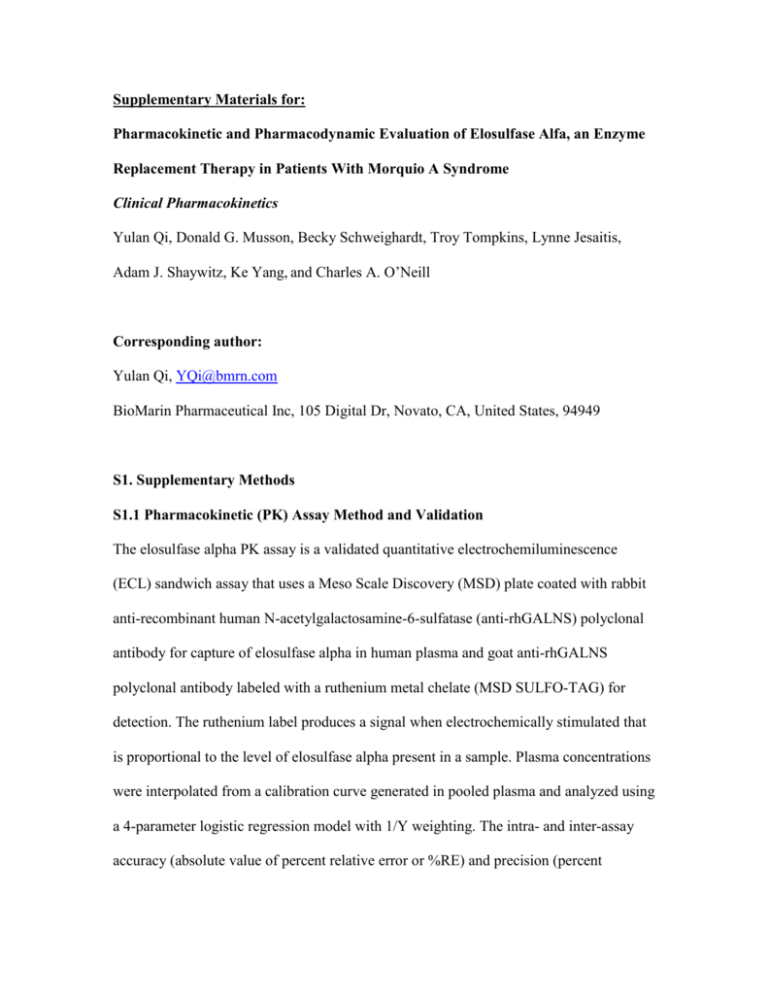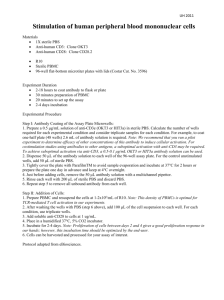Supplementary Materials for: Pharmacokinetic and
advertisement

Supplementary Materials for: Pharmacokinetic and Pharmacodynamic Evaluation of Elosulfase Alfa, an Enzyme Replacement Therapy in Patients With Morquio A Syndrome Clinical Pharmacokinetics Yulan Qi, Donald G. Musson, Becky Schweighardt, Troy Tompkins, Lynne Jesaitis, Adam J. Shaywitz, Ke Yang, and Charles A. O’Neill Corresponding author: Yulan Qi, YQi@bmrn.com BioMarin Pharmaceutical Inc, 105 Digital Dr, Novato, CA, United States, 94949 S1. Supplementary Methods S1.1 Pharmacokinetic (PK) Assay Method and Validation The elosulfase alpha PK assay is a validated quantitative electrochemiluminescence (ECL) sandwich assay that uses a Meso Scale Discovery (MSD) plate coated with rabbit anti-recombinant human N-acetylgalactosamine-6-sulfatase (anti-rhGALNS) polyclonal antibody for capture of elosulfase alpha in human plasma and goat anti-rhGALNS polyclonal antibody labeled with a ruthenium metal chelate (MSD SULFO-TAG) for detection. The ruthenium label produces a signal when electrochemically stimulated that is proportional to the level of elosulfase alpha present in a sample. Plasma concentrations were interpolated from a calibration curve generated in pooled plasma and analyzed using a 4-parameter logistic regression model with 1/Y weighting. The intra- and inter-assay accuracy (absolute value of percent relative error or %RE) and precision (percent coefficient of variation or %CV) of the lower limit of quantitation (LLOQ, 15.6 ng/mL) and upper limit of quantitation (ULOQ, 1000 ng/mL) positive controls during validation defined the extent of the quantitative range. Inter-assay performance of the calibrator curve from 15.6 to 1000 ng/mL was confirmed by individual calibrator RE and CV values of 7.7% or below and a mean R-squared value of 0.9985 (0.11% CV). Incurred sample reproducibility was demonstrated by reanalysis of approximately 10% of MOR004 study samples. The relative differences of 100 out of 112 samples reanalyzed (89.3%) were ≤ 30.0% of the original and reanalysis mean concentration. S1.2 Urine Keratan Sulfate Assay Method and Validation Keratan sulfate (KS) in urine samples was enzymatically digested by keratanase II prior to tandem mass spectrometry analysis, producing 2 major disaccharides, Gal14GlcNAc(6S) and Gal(6S)1-4GlcNAc(6S). After digestion, internal standards, heavy isotope-labeled Gal1-4GlcNAc(6S) and heavy isotope-labeled Gal1-4GlcNAc(6S), were added to the samples and large molecules (eg protein) were removed by centrifugation through 5,000 or 10,000 nominal molecular weight limit spin filters. Processed samples were chromatographed on a Hypercarb column (50 × 2.1 mm, 5 μm, Thermo) with gradient elution and the eluant transferred directly to a triple quadrupole mass spectrometer (API 4000) operating in negative electrospray ionization mode. The peak of each disaccharide and internal standard was integrated and disaccharide-tointernal standard peak area ratio was used for quantification. The concentrations of disaccharides in unknown samples were interpolated from an unweighted power curve of standards of known concentration. The validated inter-day accuracy (% nominal concentration) of the disaccharide calibrators from the LLOQ to the ULOQ concentrations (0.104-20 μg/mL for each disaccharide) ranged from 94% to 106% and the signal to noise ratios of the disaccharide LLOQ calibrators were greater than 5. Disaccharide positive control intra- and inter-day precision ranged from 1% to 5% relative standard deviation (RSDa). The intra- and inter-day precision of KS enzyme digestion ranged from 1% to 6% RSD. The method was developed, validated, and performed by Bay Bioanalytical Laboratories, Inc. a RSD and %CV are both calculated using the equation: 100 x (standard deviation/mean) S1.3 Total anti-elosulfase antibody (TAb) assay method and validation The presence of total antibodies to elosulfase alpha in human serum was determined using a validated qualitative ECL bridging immunoassay. Serum antibodies that bind to and bridge biotin-conjugated rhGALNS and SULFO-TAG-labeled rhGALNS were captured via the biotin label on a streptavidin-coated MSD plate and detected by the SULFO-TAG label upon electrochemical stimulation. TAb-positive samples were confirmed for elosulfase alfa specificity by competition with excess unlabeled drug and serially diluted to obtain a titer. Because a human elosulfase alpha–specific antibody was not available, a goat anti-rhGALNS polyclonal antibody was used as a surrogate positive control in pooled human serum. Assay sensitivity was determined to be 5.6 ng/mL of positive control antibody and validation intra- and inter-assay precision of the positive controls was 11.2% CV or below. The inter-assay precision of the titer positive control was less than ± 1 dilution of the median dilution. S1.4 Anti-elosulfase alpha–neutralizing antibody (NAb) assay method and validation A validated qualitative ligand receptor-binding neutralization assay was used to determine if patient samples with a confirmed positive TAb result could neutralize the binding of elosulfase alpha to its receptor, the cation-independent mannose-6-phosphate receptor (CI-M6PR), immobilized on an ELISA plate. Samples were initially preincubated with biotinylated elosulfase alpha and following incubation of the mixture on a coated plate, receptor-bound biotinylated rhGALNS was detected with streptavidin horseradish peroxidase and a fluorogenic peroxidase substrate, QuantaBlu. A relative reduction in signal suggested the presence of neutralizing antibodies. Screen-positive samples were confirmed for elosulfase alpha specificity by immunodepletion with rhGALNS-conjugated magnetic beads. Drug-specific samples were reported as positive and non-specific samples as negative. A goat anti-rhGALNS polyclonal antibody that neutralizes binding to CI-M6PR was used as a surrogate positive control in pooled human serum. The assay limit of detection was 2.16 μg/mL of positive control antibody and intra and inter-assay precision of positive control samples during validation was 12.0 and 28.9% CV or below, respectively.
![Anti-Integrin alpha E antibody [2E7] ab25198 Product datasheet Overview Product name](http://s2.studylib.net/store/data/012448311_1-33dc9b0e535c0628b32d5dc121540788-300x300.png)


